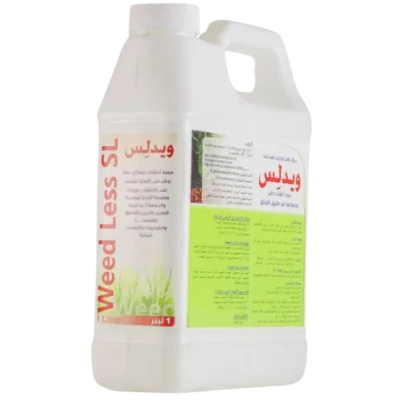Info:
Weed Less (glyphosate herbicide) is a general and systemic herbicide effect on leaves It is a general systemic herbicide has sprayed the leaves to eliminate broad-leaved and thin-leaved perennials, annuals (including turf, resin, blackberry, and Saad...), shrubs, and aquatic weeds.
Group:
herbicide
Application and Uses of Weed Less:
uses: - Before planting / before planting the crop Before the grain is harvested after it has stopped growing - after harvest - Directional spraying under fruit trees (citrus, vine, almond, apple, olive, woodland, etc.) Industrial and non-agricultural areas such as oil stations, railways, road edges, etc. - Aquatic herbs such as reeds, water lettuce, aquatic plants... timing of use: Very important The best time to control aquatic weeds is just before or when flowering. The appearance of the results of spraying on herbs: Control results appear on Houthi weeds within 1-2 weeks of spraying, and on perennials within 2 weeks Spray devices: Use traditional back spray, arm, and valet herbicide sprayers.
Usage rate for Weed Less:
Use rates on agricultural land: 2 - 8 liters/ha to control perennial weeds. 1 - 4 liters/ha to control annual weeds. Spray fluid volume 150-250 l/ha Pre-harvest uses: Weedless can be used to control weeds before harvesting wheat and barley after the crop stops growing, but the grain moisture should not exceed 30% when treating and spraying 7-14 days before harvest. Post-harvest uses: It is applied to wheat, barley, and corn crops according to the harvest date, and it is effective for controlling weeds, funnel fall, barley, and potatoes. Under and around fruit trees and vines: 8-10 liters/ha to control perennial weeds 2 - 6 liters per hectare to control annual weeds Spray fluid volume 200-600L/ha Aquatic herbs: 1 - 10 liters/ha
Mixing:
Weed Less (glyphosate herbicide) can be sprayed alone and mixed with ammonium sulfate or an adhesive/diffuser to improve effectiveness on some herbs.
Warnings:
Avoid spraying plants that are desired to remain, or they will be damaged and harmed, and do not work the land before 7 days of spraying. Weeds should not be cut or plowed before spraying. Do not mix and lubricate with other chemicals. Do not spray weeds if watering or rain is expected within 6 hours. Use a foal with a protective incubator to avoid exposing the crop to the risk of contamination with pesticide spray
Toxicity:
Oral LD50 for rats over 5000 mg/kg. LD50 per rat dermal is more than 2000 mg/kg. WHO toxicological classification: III+ No poisoning is likely within the recommended application rates. * Phytotoxicity and effect on subsequent crops: When the pesticide spray reaches the neighboring crops, it is quickly degraded in the soil by soil bacteria, so it does not affect the subsequent crops.
Notes:
Weed Less (glyphosate herbicide) is a systemic general pesticide that is absorbed through the leaves, is quickly absorbed and distributed within the plant, and its effect stops when it comes into contact with the soil. spray timing: Annuals The herbs to be sprayed must be green and at the height of their growth activity. Perennial before flowering or immediately upon flowering
Useful Links:
Composition:
| N-(phosphonomethyl) glycine monoisopropylamine salt | 480 | g |
| Equivalent to Glyphosate | 360 | g |





